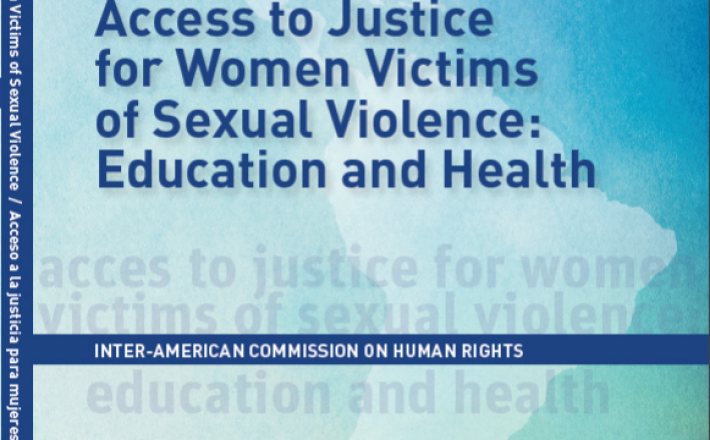ACCESS TO JUSTICE FOR WOMEN VICTIMS OF SEXUAL VIOLENCE: EDUCATION AND HEALTH
Time and time again, the Inter‐American Commission on Human Rights (hereinafter the “IACHR” or the “Commission”) has stressed how vital access to justice is to eradicating violence against women once and for all. On a number of occasions, the Commission has enumerated what duties are incumbent upon the States to accomplish that objective. However, the present report will illustrate how often –albeit in some places more than others‐ women victims of sexual violence are unable to avail themselves of any real, effective and timely judicial remedies when they become victims of sexual violence, which only serves to perpetuate this very serious human rights problem. This report examines sexual violence in the education and health areas in the Americas; analyzes the human rights standards pertinent to addressing these issues; and discusses the principal barriers that women encounter in obtaining an access to justice when they fall victim to violence of this kind and in these settings. To prepare this preliminary assessment of the prevalence and extent of sexual violence in schools and health facilities, the IACHR has compiled and examined records and information from the States, international organizations, nongovernmental organizations, the press, and universities in the region. Taking a human rights perspective and bearing in mind the obligations undertaken by the States in this area, the report also looks at how sexual violence against women prevents them from exercising their rights to education and health. The purpose of this report is to set in motion a discussion of the principal barriers that women encounter in endeavoring to get access to effective judicial recourse, all with a view to finding a solution to this problem. This report was spearheaded by the current Rapporteur on the Rights of Women, Luz Patricia Mejía (...)

Time and time again, the Inter‐American Commission on Human Rights (hereinafter the “IACHR” or the “Commission”) has stressed how vital access to justice is to eradicating violence against women once and for all. On a number of occasions, the Commission has enumerated what duties are incumbent upon the States to accomplish that objective. However, the present report will illustrate how often –albeit in some places more than others‐ women victims of sexual violence are unable to avail themselves of any real, effective and timely judicial remedies when they become victims of sexual violence, which only serves to perpetuate this very serious human rights problem. This report examines sexual violence in the education and health areas in the Americas; analyzes the human rights standards pertinent to addressing these issues; and discusses the principal barriers that women encounter in obtaining an access to justice when they fall victim to violence of this kind and in these settings. To prepare this preliminary assessment of the prevalence and extent of sexual violence in schools and health facilities, the IACHR has compiled and examined records and information from the States, international organizations, nongovernmental organizations, the press, and universities in the region. Taking a human rights perspective and bearing in mind the obligations undertaken by the States in this area, the report also looks at how sexual violence against women prevents them from exercising their rights to education and health. The purpose of this report is to set in motion a discussion of the principal barriers that women encounter in endeavoring to get access to effective judicial recourse, all with a view to finding a solution to this problem. This report was spearheaded by the current Rapporteur on the Rights of Women, Luz Patricia Mejía (...)